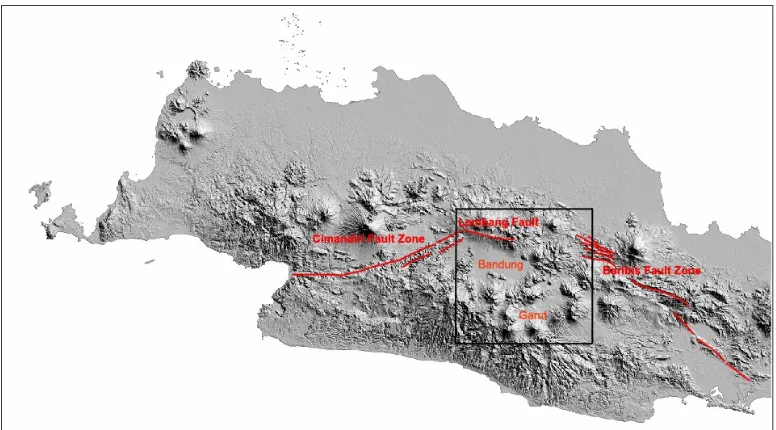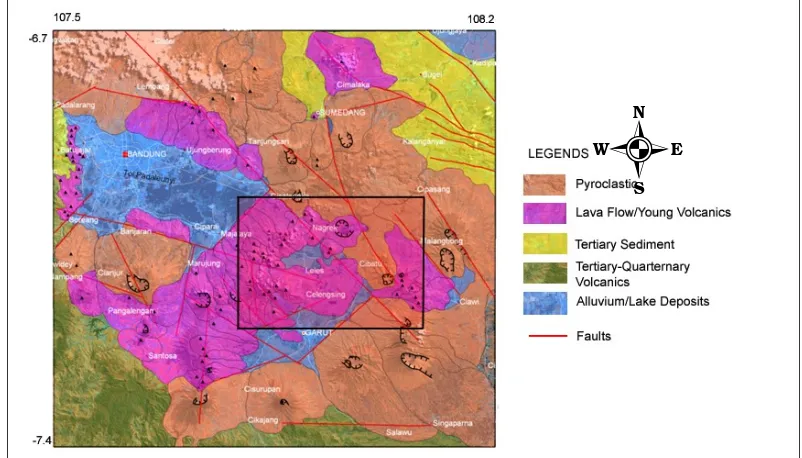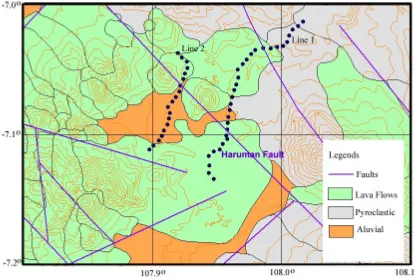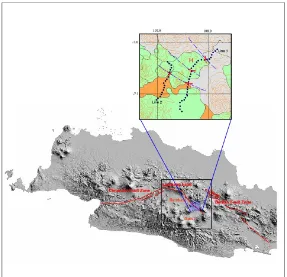Handayani, Lina., dkk / Riset Geologi dan Pertambangan Vol. 22 No.1 (2012), 25-31.
@2012 Puslit Geoteknologi
Lembaga Ilmu Pengetahuan Indonesia
25
GRAVITY MODELING OF HARUMAN FAULT AT THE EAST
BOUNDARY OF BANDUNG BASIN
Pemodelan Gayaberat Sesar Haruman Di Sisi Timur Cekungan
Bandung
Lina Handayani, Dadan D. Wardhana, Yayat Sudrajat
ABSTRACT
Bandung area, as one of most populated area in Indonesia and one region with a high risk of earthquake hazard, needs a comprehensive mitigation work. To locate active faults is one of the most important things in preliminary survey for earthquake hazard mitigation effort. Accordingly, two transect lines of gravity measurement were completed across a suspected active fault (Haruman Fault) at the east of Bandung Basin region. The subsurface modeling has presented a general idea of geological subsurface structure of this transects area and indicates the possible existences of faults at the east boundary of Bandung-Garut Basin.Keywords: active faults, gravity, earthquake, mitigation, Bandung Basin.
Naskah masuk : 9 Januari 2012 Naskah diterima : 28 Mei 2012
Lina Handayani
Research Center for Geotechnology, Indonesian Institute of Sciences, Bandung 40135
E-mail: lina@geotek.lipi.go.id
Dadan D. Wardhana
Research Center for Geotechnology, Indonesian Institute of Sciences, Bandung 40135
E-mail: wardhana@geotek.lipi.go.id
Yayat Sudrajat
Research Center for Geotechnology, Indonesian Institute of Sciences, Bandung 40135
E-mail: yayat.sudrajat@geotek.lipi.gi.id
ABSTRAK
Daerah Bandung dan sekitarnya,sebagai salah satu daerah dengan populasi yang tinggi di Indonesia dan sebagai satu daerah dengan resiko bencana gempabumi yang tinggi, sangat memerlukan usaha mitigasi yang menyeluruh. Penentuan lokasi sesar-sesar aktif merupakan satu hal yang sangat penting yang harus dilakukan pada tahap awal dalam usaha mitigasi bencana. Untuk keperluan tersebut, pengukuran gayaberat telah dilakukan di sisi timur Cekungan Bandung, pada dua garis lintasan yang memotong struktur yang diduga merupakan sesar aktif (Sesar Haruman). Pemodelan bawah permukaan menggambarkan kondisi umum dari struktur geologi daerah lintasan ini dan mengindikasikan adanya sesar-sesar di batas timur Cekungan Bandung. subduction zone earthquakes. However, Bandung is still prone to the earthquake disasters. There are three types of earthquakes that might impact Bandung - Garut area. First, the shallow subduction zone earthquakes that sources far south of Java coastline were still would impact this area. For example, the Tasikmalaya earthquake on September 2, 2009 at M ~ 7 with epicenter at more than 100 km south of Bandung (south off-coast) had damaged several building in the town. The second type is the deep subduction zone earthquakes. The Indramayu earthquake on August 8, 2007 with epicenter north of Indramayu (north coast of Java), that has M ~ 7.5 and depth of 290 km, had shaken Bandung area. Although there was no damage reported, the shake felt immensely. The third type of the earthquake is caused by local ISSN 0125-9849, e-ISSN 2354-6638
Handayani, Lina., dkk / Riset Geologi dan Pertambangan Vol. 22 No.1 (2012), 25-31.
26
Figure 1. Active faults in West Java Region (Abidin
et al.,
2009; Martodjojo, 2003; Dardji
et
al
., 1994).The area inside the box is the region of Landsat Interpretation presented at
Figure 2.
faults. These earthquakes are more risky since they usually have shallow focus that might destroy almost anything close by. For example is the Yogyakarta (Bantul) Earthquake (May 26, 2006) with M ~ 5.9, that was triggered by a local fault. The earthquake caused thousands of fatalities and hundreds thousands of houses damaged or destroyed.
Recently (September 2011), people lives in Cisarua area (north of Bandung) had experienced a couple of small earthquakes (M ~ 2.8 and M ~ 3.3) that damaged their houses. The epicenter is located at the west part of the Lembang Fault. Lembang Fault is located at the north of Bandung and has a clear physical morphology of a fault. Many researches have been going on to study
Lembang Fault’s activity (Abidin, et al., 2009;
Hidayat et al., 2008). However, Lembang Fault is not the only fault that might impact Bandung and its surrounding. Marjiyono et al. (2008) for example, indicated several small earthquakes events with sources are at several locations around Bandung. Some locations were known by public as earthquake zone since the local people had experienced small shakes that affect their building. For instance, people who lives in Pangalengan (south of Bandung), Rajamandala (west of Bandung), and Cicalengka (east of Bandung) had experienced several small earthquakes during their life time. The earthquakes had M < 5, so they were
not recorded by most of the worldwide networks. Several local seismographs should record the shakes, but data from a few (less than 3) stations would not be able to give a complete and precise analysis of the earthquakes. To analyze a complete possible earthquake hazard in Bandung area, it is essential to find and to map any faults as possible sources of the earthquakes. We started with mapping the possible faults from Landsat Image interpretation (Figure 2). Then, geophysical study is needed to verify the existence of these faults. Untung et al. (1978) had introduced a regional gravity map based on their gravity survey, which had resolution of about 5 km. Accordingly, we made a gravity survey with shorter intervals, to give us better resolution in the subsurface structure modelling.
On this paper, we present our result in gravity measurement and forward modeling across a straight line fault that we call as Haruman Fault. The result indicates our subsurface structures model confirmed the possible existence of fault lines at the east of Bandung Basin.
Regional Setting
Handayani, Lina., dkk / Riset Geologi dan Pertambangan Vol. 22 No.1 (2012), 25-31.
@2012 Puslit Geoteknologi
Lembaga Ilmu Pengetahuan Indonesia
27
Figure 2. Geological Interpretation from Landsat Image. The black box is the study area
represented in Figure 3.
from Pelabuhan Ratu to Padalarang, including Rajamandala Fault at the west of Bandung. The sinistral strike slip fault zone (Dardji, et al., 1992) is an active fault as indicated by several earthquakes that continuously occurred in this zone. Baribis Fault Zone, which was mentioned in
Bemmelen (1949) and Martodjojo (2003),
extended from the anticlinorium complex near Majalengka to the southeast direction. At the north of Bandung, Lembang Fault is a morphological lineation that clearly suggested as a fault. Abidin et al. (2009) indicated that the horizontal displacements of the three fault zones are about 0.5 to 2 cm/year with the lowest number applied to Lembang Fault.
We assumed that Bandung and Garut Basin as one large basin based on the interpretation of geological condition as presented in Figure 2. Most area is covered by igneous rocks, except on the west side where we can find Tertiary sediment rocks. Pyroclastic rocks bordered the great basin area and formed a horseshoe shape that opens to the west. Older and ancient volcanoes (calderas) are located at Subang area, north of Bandung. The oldest igneous rock that had been identified is from Middle Paleocene (Kartadinata, et al., 2002), taken from Cupunagara area (Subang). At the east, there are Tampomas, Talagabodas and Galunggung
Volcanoes. Chains of Patuha, Papandayan and Cikuray Volcanoes are at the south border.
In the middle of the basin, lava flow or young volcanic rocks separated the large depression to be the Bandung and Garut Basins. In this part, there are Guntur-Kamojang Volcanoes between the Bandung Basin and Garut Basin. Younger volcanoes also bordered north of Bandung that
include Burangrang, Tangkubanparahu,
Bukittunggul, and Manglayang Volcanoes.
Younger (Quarter) igneous rocks were found in Tangkubanparahu, Guntur, and Malabar Volcanoes (Bronto & Hartono, 2006; Dam, 1994).
METHODOLOGY
The faults lineation map (Figure 2) shows several faults at Bandung area. One long fault appears on the east side of the basin, elongated NW-SE from the north, at the east end of Lembang Fault, to the
southeast, at about Mount Galunggung,
Tasikmalaya Regency. The fault line crosses
Tanjungsari – Cicalengka – Haruman –
Galunggung. On this study, we only surveyed the west and east side of Mount Haruman, thus in this paper it will be mentioned as “Haruman Fault”. There are several indications that the fault is active. First, the line was drawn connecting several small volcanic cones. The cones are the signature of an active fault, where its recent activity formed
Handayani, Lina., dkk / Riset Geologi dan Pertambangan Vol. 22 No.1 (2012), 25-31.
28
Figure 3. Transect lines (blue dots) of gravity measurement.
the volcanic cones. Second, several small earthquakes (M < 5) had been reported in this area (Marjiyono et al., 2008). To confirm the fault existence, we approached it with gravity methods.
Gravity Measurement and Modeling
Gravity survey is a geophysic measurement based on finding the gravity anomaly, that caused by subsurface rock density inhomogeneity. By maping the density distribution of subsurface, we can detect density contrasts that might give the indication of any geological structures. From the survey, we acquired the observed gravity data, which is influenced by many factors. Therefore, the observed gravity data should be reduced by several correction. For general land survey and with a purpose to get the effects of densities distribution of subsurface, we used the complete Bouguer anomaly correction method.
Gravity bouguer anomaly is calculated as
g = (go– 2Gh + Tc) –H) + Ac (1)
where go is observed gravity, is the mean density
of subsurface, G is gravity constant, h is the height from mean sea level, Tc is field correction, is normal gravity, is gravity vertical gradient, and Ac is free air correction. Normal gravity value is calculated based on International Gravity Formula 1967 (The Geodetic Reference System1967):
2 4
sin 000023462 .
0 sin 005278895 .
0 1 85 . 031 ,
978
mGal. (2)
where
is the latitude of measurement point. The free air correction (Ac) is calculated asAc = 0.87 – 0.0000965h mGal (3)
Handayani, Lina., dkk / Riset Geologi dan Pertambangan Vol. 22 No.1 (2012), 25-31.
@2012 Puslit Geoteknologi
Lembaga Ilmu Pengetahuan Indonesia
29
F
igure 4. Gravity Modeling Line 1 (on the graph above: dots = measured gravity, line = calculatedgravity, on the model below: numbers indicate the density in cm/gr3).
The measurements were done using La Coste & Romberg Gravity Meter on two transects across the fault at the west and east sides of a volcanic cone, Mount Haruman (Figure 3). There are 32 points in Line 1 (SL), which is on the east side of the cone and 20 points in Line 2 (NR), which is on the west of the cone.
RESULT AND DISCUSSION
The two transects of gravity measurements gave us two Bouguer Gravity Anomaly Curves (Figure 4 and 5). The Bouguer Anomaly of Line 1 indicates high anomalies in the middle, in line with the volcanic cones. The high anomalies also observed at about the same part at the other transect.
Based on these gravity anomalies values, the forward gravity modeling was completed using GM-SYS 2D Profile Modeling software. Two models (Figure 4 and 5) show the subsurface structure models along transect lines, indicated with the approximate densities of possible layering. The densities values were approached based on the Average Densities Table (Wohletz &
Heiken, 1992) of the predicted type of rocks from this geological area.
In general, the models present the layering of alluvial (density = 1.9 g/cm3), lava (density = 2.65 g/cm3), pyroclastic (density = 2.2 g/cm3), Tertiary sediment (density = 2.4 g/cm3) and the bottom two are older - higher densities of igneous rocks (density = 2.7 and 2.8 g/cm3). A massive high density layer that appears beneath the middle part of the Line 1 (Figure 4) might explain the existence of active volcanoes at this zone. Two igneous bodies hypothetically exist in this section. They might represent some igneous intrusion. However, no intrusions observed on the surface of this area. The similar general feature at the north side of the transect Line 2 (Figure 5) indicates the continuous high density zone to the northwest (see
“H” at Figure 6).
Handayani, Lina., dkk / Riset Geologi dan Pertambangan Vol. 22 No.1 (2012), 25-31.
30
Figure 5. Gravity Modeling Line 2 (on the graph above: dots = measured gravity, line = calculated gravity, on the model below: numbers indicate the density in cm/gr3).
Figure 6. Predicted faults from the gravity anomaly modeling (above) as a part of the fault
complex at West Java (bottom).
Handayani, Lina., dkk / Riset Geologi dan Pertambangan Vol. 22 No.1 (2012), 25-31. south and we call it Haruman Fault. The fault line location appear slightly shifted from the previous prediction as shown in Figure 2. Moreover, the Haruman fault represents a small part of the longer fault line drawn at the east of Bandung-Garut (blue box in Figure 6, bottom). Nevertheless, it is a significant verification of the existence of those NW-SE trend fault zone at this location.
This NW-SE trend thrust fault zone at the east of Bandung-Garut is probably connected to the Lembang Fault at its east end and parallel to the Baribis Fault Zone. The thrust system also matches with the thrust complex of Baribis Fault Zone and corresponds well to the movement of sinistral strike slip of Cimandiri Fault Zone. Those movements are common tectonic features at the fore-arc zone due to the compressional force of the subduction system.
CONCLUSION
Gravity survey and forward modeling of the Bouguer gravity anomaly has produced subsurface models that indicate the existence of faults at the east boundary of Bandung-Garut Basin. The faults are about parallel to the Baribis Fault Zone and probably connected to the east end of Lembang Fault. Although some more thorough other geophysical surveys were suggested, this result is adequate as an indication of the imminent threat from these faults that might be active. It should also prompt us to search for other possible sources of shallow earthquakes around Bandung Basin region.
Acknowledgement
This work is a part of a project funded by Research Center for Geotechnology LIPI (DIPA) fiscal year of 2009. We are grateful for all the discussion and recommendation suggested by Hery Harjono and Kamtono.
References
Abidin, H. Z., Andreas, H., Kato, T., Ito, T., Meilano, I., Kimata, F., Natawidjaja , D., Harjono, H., 2009. Crustal deformation studies in Java (Indonesia) using GPS, Journal of Earthquake and Tsunami, Vol. 3, No. 2, 77– 88.
Bemmelen, R.W. van, 1949. The Geology of Indonesia, Vol, 1A, General Geology of
Indonesia and Adjacent Archipelagoes.
Government Printing Office, The Hague.
Bronto, S., Hartono, U., 2006. Potensi Sumber Daya Geologi di Daerah Cekungan Bandung dan sekitarnya. Jurnal Geologi Indonesia, 1 (1), 9-18. 1994. Paleostresses and strike-slip movement: The Cimandiri Fault Zone, West Java, Indonesia. Journal of Southeast Asian Earth Sciences, 9(I/2), 3–11.
Hidayat, E., Brahmantyo, B., Yulianto, E., 2008.
Analisis Endapan Sagpond pada Sesar
Lembang. Jurnal Geoaplika, Volume 3, Nomor 3, hal. 151 – 161.
Kartadinata, M.N., Okuno, M., Nakamura, T., Kobayashi, T., 2002. Eruptive History of
Tangkubanparahu Volcano, West Java,
Indonesia: A Preliminary Report. Journal of Geography, 111(3), 404-409.
Marjiyono, Soehamini, A., Karmawan, 2008. Identifikasi Sesar Aktif Daerah Cekungan Bandung dengan Data Citra Landsat dan Kegempaan. Jurnal Sumber Daya Geologi, Vol. 18, No. 2, 81 – 88.
Martodjojo, S., 2003. Evolusi Cekungan Bogor Jawa Barat, Penerbit ITB Bandung.
Untung, M. dan Sato, Y., 1978. Gravity and Geological Studies in Jawa, Indonesia. Geological Survey of Indonesia & Geological Survey of Japan.



